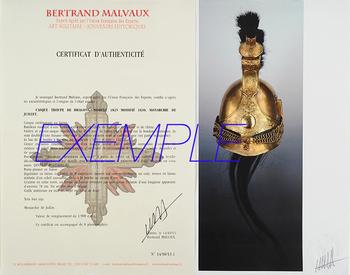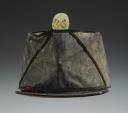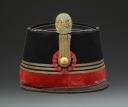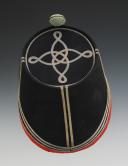
CAPTAIN'S RIGID KEPI OF THE 28TH BATTALION OF THE MOBILE NATIONAL GUARD, SECOND EMPIRE (around 1860-1870). 28026
Sold out
CAPTAIN'S RIGID KEPI OF THE 28TH BATTALION OF THE MOBILE NATIONAL GUARD, SECOND EMPIRE (around 1860-1870). 28026
Hat in dark blue, almost black cloth (H at the front 9.5 cm, H at the back with the curvature 15.4 cm) with madder headband (H 2.5 cm). Soutaches in flat silver braids, cap in dark blue, almost black cloth with flat silver braids in the shape of a Hungarian knot. Square visor in black patent leather, green oilskin underneath, lined with a folded leather band astride the outer edge. Bottom of the headband at the visor edged with a black wool braid. Roundel in tricolor trimmings. Silver trimmings strap held in the center of the cockade by a half-spherical gilded brass button. Flat braid in silver trimmings bordering the top of the visor at the base of the headband. Inner headdress composed of a band of black waxed leather gilded with iron and crimson silk. Lenticular oval-shaped wooden pompom covered in sky blue cloth with silver trimmings cord and cut-out golden brass number “28” attached to the front.
Black oilcloth shako cover.
France.
Second Empire.
Good condition, wear on the lower part of the headband, worn interior cap, some accidents and missing parts of the shako cover.
HISTORY:
The Mobile National Guard, called the Mobiles, for short, and Les Moblots colloquially, was created by the law of February 1, 1868 in order to serve as an auxiliary to the active army in the defense of strongholds, towns, coasts, borders of the 'Empire, and the maintenance of internal order
When the Franco-Prussian War broke out in July 1870, the Mobile Guard, failing to organize itself, appeared on the registers only as a reminder (statement by Marshal Le Boeuf, Minister of War in 1870). The Mobiles were poorly armed and trained. Units often lacked cohesion and training; they were supervised and disciplined in a very variable but almost always insufficient way. However, two months after the defeat, the fighting had engulfed 9/10ths of the regular army.
The Mobile Guard then found itself representing the bulk of the French armed forces. It is with this last resource that the Nation, having become republican, put up a prolonged military resistance to the invader for six months. The courage, self-sacrifice and heroism, despite their unpreparedness for war, are to the credit of these units.
In Belfort, during the siege held by the Prussian troops of General von Werder, the garrison included 12,800 mobiles. This represented three quarters of the latter's total workforce. These troops defended the place for more than three months, from November 4, 1870 to February 18, 1871. The mobiles stood guard, manned the cannons, moved the earth and wielded the shovel on the ramparts of the castle, the Miotte, the Justice, Perches... They organized the defense of the place, then fought with the enemy the positions of Valdoie, Perugia - Danjoutin - Cravanche, from where the latter led the siege of the city.
They participated in “outings” to Bessoncourt, Chèvremont, Andelnans, etc. They suffered, day and night, from an intense bombardment launched on December 7, 1870. The troops were wildly hopeful when Bourbaki's relief army had reached Lizaine, near Montbéliard-Héricourt. Despite the retreat after the Battle of Héricourt, they nevertheless continued to fight.
In Normandy, the mobiles of Eure and Loire-Inférieure reinforced by those of Ardèche fought until the first days of 1871.
In Champagne, the mobiles of the 4th infantry battalion and the first battery of the Marne were grouped together at Vitry-le-François on an order from the Minister of War, before being directed towards Argonne. Commanded by Duval, Terquem and Michaud, these 1500 men fought at the Basse farm between Dampierre-le-Château and Sivry-sur-Ante. They were beaten and taken prisoner, crossing Passavant-en-Argonne, 32 of them were shot and a hundred wounded; a monument in honor of their sacrifice is erected there.
The Mobile formations disappeared after the conflict to make way for units made up of reservists, trained and supervised by the Army Service.
Hat in dark blue, almost black cloth (H at the front 9.5 cm, H at the back with the curvature 15.4 cm) with madder headband (H 2.5 cm). Soutaches in flat silver braids, cap in dark blue, almost black cloth with flat silver braids in the shape of a Hungarian knot. Square visor in black patent leather, green oilskin underneath, lined with a folded leather band astride the outer edge. Bottom of the headband at the visor edged with a black wool braid. Roundel in tricolor trimmings. Silver trimmings strap held in the center of the cockade by a half-spherical gilded brass button. Flat braid in silver trimmings bordering the top of the visor at the base of the headband. Inner headdress composed of a band of black waxed leather gilded with iron and crimson silk. Lenticular oval-shaped wooden pompom covered in sky blue cloth with silver trimmings cord and cut-out golden brass number “28” attached to the front.
Black oilcloth shako cover.
France.
Second Empire.
Good condition, wear on the lower part of the headband, worn interior cap, some accidents and missing parts of the shako cover.
HISTORY:
The Mobile National Guard, called the Mobiles, for short, and Les Moblots colloquially, was created by the law of February 1, 1868 in order to serve as an auxiliary to the active army in the defense of strongholds, towns, coasts, borders of the 'Empire, and the maintenance of internal order
When the Franco-Prussian War broke out in July 1870, the Mobile Guard, failing to organize itself, appeared on the registers only as a reminder (statement by Marshal Le Boeuf, Minister of War in 1870). The Mobiles were poorly armed and trained. Units often lacked cohesion and training; they were supervised and disciplined in a very variable but almost always insufficient way. However, two months after the defeat, the fighting had engulfed 9/10ths of the regular army.
The Mobile Guard then found itself representing the bulk of the French armed forces. It is with this last resource that the Nation, having become republican, put up a prolonged military resistance to the invader for six months. The courage, self-sacrifice and heroism, despite their unpreparedness for war, are to the credit of these units.
In Belfort, during the siege held by the Prussian troops of General von Werder, the garrison included 12,800 mobiles. This represented three quarters of the latter's total workforce. These troops defended the place for more than three months, from November 4, 1870 to February 18, 1871. The mobiles stood guard, manned the cannons, moved the earth and wielded the shovel on the ramparts of the castle, the Miotte, the Justice, Perches... They organized the defense of the place, then fought with the enemy the positions of Valdoie, Perugia - Danjoutin - Cravanche, from where the latter led the siege of the city.
They participated in “outings” to Bessoncourt, Chèvremont, Andelnans, etc. They suffered, day and night, from an intense bombardment launched on December 7, 1870. The troops were wildly hopeful when Bourbaki's relief army had reached Lizaine, near Montbéliard-Héricourt. Despite the retreat after the Battle of Héricourt, they nevertheless continued to fight.
In Normandy, the mobiles of Eure and Loire-Inférieure reinforced by those of Ardèche fought until the first days of 1871.
In Champagne, the mobiles of the 4th infantry battalion and the first battery of the Marne were grouped together at Vitry-le-François on an order from the Minister of War, before being directed towards Argonne. Commanded by Duval, Terquem and Michaud, these 1500 men fought at the Basse farm between Dampierre-le-Château and Sivry-sur-Ante. They were beaten and taken prisoner, crossing Passavant-en-Argonne, 32 of them were shot and a hundred wounded; a monument in honor of their sacrifice is erected there.
The Mobile formations disappeared after the conflict to make way for units made up of reservists, trained and supervised by the Army Service.
Reference :
28026

Next update Friday, april 4th at 1:30 PM
FOR ALL PURCHASES, PAYMENT IN MULTIPLE CHECKS POSSIBLE
bertrand.malvaux@wanadoo.fr 06 07 75 74 63
An authenticity certificate of the item including the description published on the site, the period, the sale price, accompanied by one or more color photographs is automatically provided for any item priced over 130 euros. Below this price, each certificate is charged 5 euros.
Only items sold by me are subject to an authenticity certificate, I do not provide any expert reports for items sold by third parties (colleagues or collectors).










